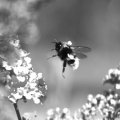A University of Queensland academic has developed a computer model to identify and predict the world's most endangered birds.
Five years ago, Zoology Department lecturer Dr Ian Owens and senior research fellow from the Institute of Zoology in London Dr Peter Bennett began compiling what is believed to be the world's largest and most detailed biological database on birds.
They hope the computer model will be used by conservation groups to guide selection of species for protection.
'Some conservation groups select species for preservation based on factors such as public appeal or so-called ?fluffiness'. These species may well be rare on a local scale but are not necessarily uncommon on a world scale in terms of either their abundance or their biology,' Dr Owens said.
'While there are large numbers of bird species threatened by extinction, the resources available for their conservation are severely limited. If conservation effort is expended on species-based approaches, it is necessary to decide which species should be the focus of that effort.
'The model offers a guide for selecting those highly unusual species which make the biggest contribution to biodiversity - keeping as many evolutionary pathways open for the planet's bird life as possible.'
Funded by the United Kingdom's National Environmental Research Council, the researchers have so far compiled information on 3362 of the world's 9500 known species.
Drs Owens and Bennett have also developed an index of quantifying each species' importance in terms of representing biological diversity. This index is based on two main variables - 'vulnerability to extinction' and 'unusualness'. Each species is given a number in a scale culminating in certain species being classified as being 'highly vulnerable and highly unusual'.
For the purposes of the study, a bird's unusualness is defined as its importance to overall bird biodiversity. Generally speaking, the more unusual a species, the fewer similar relatives it has and the more unusual its biology.
'For example, there are only two species of Lyrebird in the world with one of those, Albert's Lyrebird, occurring only in Queensland's Lamington National Park. In other words, if the park was wiped out tomorrow, we would lose half the world's species of this incredibly unusual bird at once,' he said.
Two research papers explaining the measure will be published in the prestigious journal Proceedings of the Royal Society of London later this year.
Dr Owens said the computer model was unique in its combination of both biological data (50 variables including egg clutch size, mating habits, food and average life span) and phylogeny (a type of family tree identifying related species based on molecular data).
Information about each species' endangered status (if any) was added to the model from a recently published book Birds To Watch published by Bird Life International.
'We found human disturbance, the principal cause of current extinctions, does not affect all species equally. In some cases, it had more to do with the species' own biology. Certain families contain a surprisingly large proportion of threatened species with eight containing more than could be expected by chance. Extinction-prone families included the parrots, albatrosses, cranes and pigeons,' he said.
Of the 20 bird families falling into the model's 'highly vulnerable and highly unusual' category, Australasia was home to 12 - the highest proportion of any world region, Dr Owens said.
'While South-East Asia is home to the most endangered bird species and South America is home to the greatest numbers of species, Australasia has the highest number of birds meeting both criteria. Considering its total number of species, Australasia contains a disproportionately high level of bird diversity,' Dr Owens said.
He said this situation had probably developed from the region's unique evolutionary history - the break-up of Gondwana millions of years ago had resulted in many isolated islands where diverse species could flourish free from outside influences such as migration and predation.
'The region now contains arguably the most diverse and unusual group of animals on Earth. That is why it is so important Australia thinks about its conservation priorities,' he said.
Australasian birds falling into the 'highly vulnerable and highly unusual' category include New Zealand's Kiwis, New Caledonia's Kagu (a white, Heron-like bird), and the Cassowaries and the Megapodes of Australia and Papua New Guinea.
He said while the high numbers of Australasian bird species falling into the top category was cause for concern, their containment in particular areas offered an advantage for the conservation effort.
'Forty percent of these species are found in just five percent of the Australasia land mass and much of this area is already protected by national parks,' he said.
'The ongoing challenge is to develop a robust measure of ?biodiversity' that is useful in prioritising conservation effort at a local geographic scale. That's where conservation really happens.'
For more information, contact Dr Owens (telephone 3365 4823 or 3365 2491 or email iowens@mailbox.uq.edu.au).



